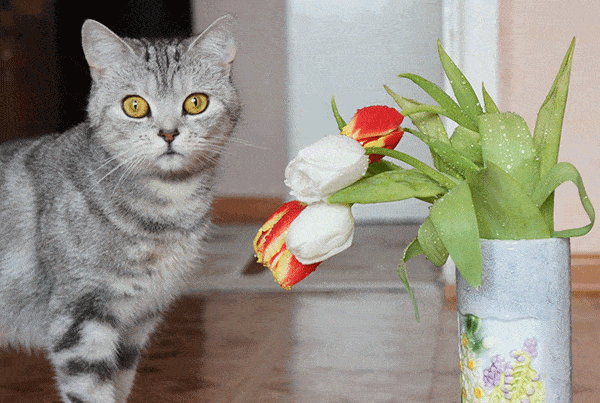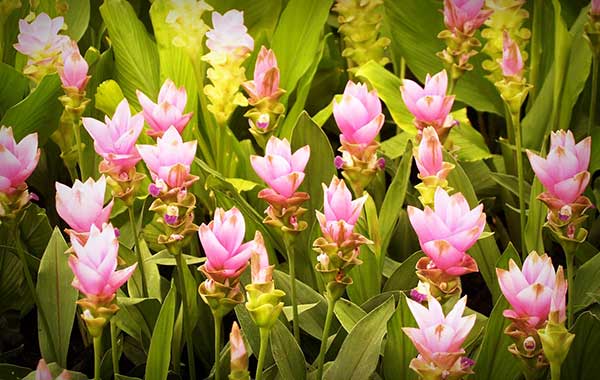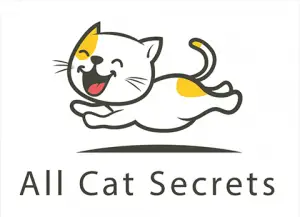Cats are inherently curious animals. They love to check out just about anything and everything that exists in and around their environments.
In the course of their investigations, cats tend to sniff, scratch, rub against, and even nibble on stuff that they shouldn’t be eating at all.
That ranges from human foods in the kitchen shelves to plastics in the trash cans and even plants in your backyard.
One of the plants that cats seem to be exceedingly attracted to is tulip. Tulips are known for their incredibly beautiful flowers.
When tulip flowers are in full bloom, they can add a stunning ambiance to your backyard. It’s probably during these times that your cat will also demonstrate heightened curiosity in tulip plants. The irresistible beauty of tulips might get your kitto nibbling on these plants.
But as a loving and responsible pet owner, you may be wondering, are tulips poisonous to cats?
The answer is a resounding yes. As beautiful as they are, tulips are highly poisonous to cats. The plants contain toxins tulipalin A and B that if ingested, might cause a series of unpleasant effects for your furry, little friend.
So, will tulips kill cats?
Well, tulips might not directly kill your cat. But as you shall find, the adverse effects and complications that arise when your kitto ingests tulip toxins might deal a severe blow to the cat’s overall health.
If your cat ate tulip leaf and are wondering what could possibly go wrong, this article is for you.
Read on as we unpack everything there is to know about cats and tulips.
Table of Contents
Are Tulips Deadly To Cats? More About Tulips
Are tulips safe for cats?
No, they aren’t. Tulips are highly toxic to your feline friend, and should be kept as far away from them as possible.
However, before we investigate tulip toxicity further, it’s important to begin easy by having an overview of what these plants are.

Tulips, also known as Tulipa, is a genus of spring-blooming, perennial bulbiferous plants.
Tulips are characterized by their large, brightly-colored flowers, which can range from red to white, pink, or yellow.
The plants belong to the Liliaceae family, which is essentially the lily family that comprises 14 other genera.
Though it’s often considered as an individual plant species, tulip is actually a genus that comprises about 75 species.
Tulips are indigenous to Southern Europe and Central Asia. However, the plants have since been naturalized in various other regions around the world.
Generally, tulips thrive in mountainous and steppes climatic environments, or other areas that feature temperate climates.
Tulips are mostly famous as ornamental plants, particularly in regions that experience the four seasons. They bloom in spring and become dormant during summers.

Tulips are also culinary plants. Their petals are used to season food, and produce the same effects as lettuce, onions, garlic, and other salad greens.
Evidently, tulips are highly beneficial to humans. Unfortunately, the same cannot be said about our feline friends. And the following sections shall expound further on that.
Do Cats Love Tulips?
Maybe you’re a cat owner and have always wondered, are tulips bad for cats?
As we’ve already pointed out, tulips are definitely bad for cats.
But then, do cats love tulips?
One of the reasons cats love certain plants is because those plants produce chemicals that mimic a cat’s pheromones.
There are no concrete studies yet, suggesting that tulips contain these chemicals. However, there’s another reason your cat may develop a love affair with these toxic plants – their flowers.
Tulips produce warm, brightly-colored flowers, the same that cats may find attractive and worth checking out.
If your cat spends a considerable amount of its time in your flower garden during spring, the chances are that the cat is attracted by the gorgeous beauty of tulips.
Sniffing tulips may not be immediately dangerous for cats. And neither is scratching the plants or rubbing against them. But the equation suddenly changes when your cat eats tulip.

What Are The Causes Of Tulip Poisoning In Cats?
We’ve already pointed out that tulips are harmful to cats. But then the question comes, why are tulips toxic to cats?
Tulips have allergenic lactones or other similar alkaloids that are highly poisonous to cats. Essentially, tulips contain toxins that are broadly characterized as tulipalin A and B, both of which present significant toxicity to cats.
What if your cat ingests tulips, how harmful can tulipalin A and B toxins be?
If ingested, these toxins can cause a wide range of clinical symptoms.
The following are some of the symptoms of tulip poisoning in cats.
- Gastrointestinal complications like nausea, vomiting, diarrhea, and abdominal pains,
- Dizziness,
- Lethargy,
- Excessive fussing and vocalization,
- Irritation to tissues around the cat’s mouth and esophagus, and
- Drooling/Hyper-salivation.
The severity of tulip poisoning in cats depends on the amount of the tulip, as well as the part of the plant that your cat has eaten.
It also depends on the general immunity of the cat. Very young, very old, sickly, and pregnant cats usually have suppressed immunities. Such cats should definitely not eat tulips in whichever quantity.
Last update on 2024-07-09 / Affiliate links / Images from Amazon Product Advertising API
If your kitto ingested a high amounts of tulip, you can expect the following symptoms;
- Elevated heart rate,
- Changes in the cat’s respiration,
- Changes in the cat’s feeding and drinking habits,
- Changes in the cat’s bowel and bladder movements,
- A lack of coordination,
- Neurological symptoms like depression, seizures and body tremors,
- Difficulty in breathing, and
- Signs of severe allergy, which may be characterized by watery eyes and nose, excessive scratching, and irritability
It’s important to note that the signs and symptoms of tulip poisoning usually show between 2 and 4 hours after ingesting the plant.
However, the window could be longer or shorter, again depending on the portions your kitto has nibbled and the parts of tulip that the cat has eaten.
But just how poisonous are tulips to cats?
Many cat owners are probably already familiar with the story of Kiki.
Kiki was a cat from the UK that died, ostensibly from tulip poisoning.
The owner, Juliet Cridlow, claims that she rarely buys tulips. On the fateful day, she bought tulips and placed the plants in a vase.
As any curious cat would do, the six-year-old Kiki went to check out the tulips her owner had brought home.

Cridlow even photographed Kiki with the tulips, blissfully unaware that this was going to be the last time she photographs her adorable pet alive.
The next morning, Cridlow discovered her cat lying on the bathmat, unconscious and motionless.
When she picked Kiki up, the cat made a weak sound, suggesting that something was amiss. She did what any loving and responsible pet parent would do – rushed Kiki to the vet.
Kiki was diagnosed with tulip poisoning. According to the vet, the plant had severely damaged Kiki’s kidneys that the only way out was to euthanize the cat.
Cridlow spent 40 minutes deciding if it was wise to go ahead and have Kiki euthanized. But as they say, “sometimes you’ve got to be cruel to be kind.”
Kiki’s story begs the question, are tulips dangerous to cats and if they are, can tulips kill cats?
Well, from the story, it’s easy to assume that tulips can kill cats, though the death may probably not come as quickly as it did. The chances are that the cat might have been suffering from an underlying kidney condition.
It’s worth noting that the American Society for the Prevention of Cruelty to Animals (ASPCA) is yet to list death as an immediate cause for tulip poisoning in cats.
Nonetheless, you want to prevent your cat from getting exposed to tulip. Even though the cat may not die from ingesting the plants, the symptoms can lead to irreversible damage to its immunity and internal organs.
- EASY TO USE, IMPACTFUL RESULTS: Collect a sample, package it up, and send it securely back. Just register, swab, return with the...
- MOST COMPREHENSIVE BREED & TRAIT: Our test distinguishes over 20+ distinct breeds and 50+ trait markers with the most...
- SCREEN FOR 40+ GENETIC DISEASES: Get peace of mind by screening for 64 health markers associated with 43 diseases for which your...
Last update on 2024-07-09 / Affiliate links / Images from Amazon Product Advertising API
You should also remember that even if tulips were ranked among the plants that cats can eat, the mere fact that it’s a plant means it’s not entirely safe for cats. That’s because cats are obligate carnivores. As such, they derive all their nutritional needs from a diet of animal protein.
As a matter of fact, the body of cats is designed in such a way that it synthesizes some of the minerals it cannot obtain from its regular diet of meat.
So, whichever way you look at it, there are limited nutritional needs that your cat can enjoy from snacking on tulips or most other plant matter.
And the fact that your cat’s digestive tract is used to processing animal proteins means that ingesting any plant matter will almost always lead to gastrointestinal irritation.
Which Parts Of Tulip Are Most Poisonous To Cats?
The best way to answer that question is to examine the toxicity of the different parts of tulip separately.
Are tulip leaves poisonous to cats?
Yes, tulip leaves contain traces of the poisonous tulipalin A and B toxins. The term “traces” doesn’t make tulip leaves any less harmful to cats though.
Are tulip petals toxic to cats?
Yes, tulip petals are just as poisonous to your feline friend as the leaves are. That also begs the question, are dried tulip petals toxic to cats if ingested? And the answer remains – yes, they are.
Is tulip pollen poisonous to cats?
Pollen are produced in the flowers. And since tulip petals are poisonous to cats, it doesn’t come as a surprise that tulip pollens are also toxic.

Are tulip stems poisonous to cats?
Just like tulip leaves and flowers, tulip stems also carry their fair share of toxicity for cats. But the toxicity from tulipalin A and B chemicals isn’t the only thing to worry about.
The stems are comparatively tougher than other parts of the tulip plant. If ingested, they might present the risks of choking for your cat.
Remember that our feline friends don’t chew their foods as well as we do. In most cases, they prefer to swallow it whole, and that’s where toxicity comes from.
Are tulip bulbs poisonous to cats?
Now, your cat may not necessarily become ill from nibbling on tulip leaves, petals, or stems. But when it comes to bulbs, then you can almost always expect some reactions.
That’s because most of the toxins in tulip are concentrated around the bulb, making them highly poisonous to cats.
Reports indicate that most cats that experience severe tulip poisoning are those that dig up and eat freshly-planted bulbs, or otherwise have access to them.
- Number 1 veterinarian-recommended cat probiotic brand to support digestive health (Kantar Veterinary Tracker, 2021), making it an...
- Purina Pro Plan Sensitive stomach cat food supplement for the dietary management of kittens and adult cats with cat diarrhea
- Digestive Care Cat Food supplement containing probiotics proven to promote intestinal health and balance
Last update on 2024-07-09 / Affiliate links / Images from Amazon Product Advertising API
Besides the parts of the tulip in question, you might also be wondering, are cut tulips toxic to cats?
Cut or not, tulips remain toxic to cats. So, will my cat be okay after eating tulips? Absolutely not. And we’ve already reviewed all the possible things that could go wrong.
Lastly, there’s the question of Siam tulips, and you might be asking, are Siam tulips poisonous to cats?
Now, it’s easy to assume that Siam tulips are the same as the ornamental tulips that most of us are used to, ostensibly due to the name similarity. Some people might even think that Siam tulips are a specie of tulips. Nothing can be further from the truth.
Scientifically known as Curcuma alismatifolia, Siam tulip is a tropical plant that’s native to Southeast Asian countries, including Cambodia, Laos, and Thailand.
Siam tulips are not taxonomically related to tulip, regardless of the name similarities. It’s actually more related to certain ginger species like turmeric. In terms of toxicity, Siam tulip also happens to be poisonous to cats.

Treatment of Tulip Poisoning in Cats
Since tulips are highly harmful to cats, the conventional wisdom is to schedule an appointment with your vet as soon as you suspect tulip poisoning.
Presently, there’s no antidote for tulip poisoning in cats, and the treatment is focused around alleviating the severity of the symptoms.
Usually, tulip poisoning treatment involves managing stomach upset, as well as correcting the dehydration that may have resulted from vomiting and diarrhea. Rehydration measures usually include administering intravenous fluids.
The vet may also recommend activated charcoal, which causes the cat to vomit and flush out any toxins that might still be left in its body.
How Do I Stop My Cat From Eating Tulips?
As there’s no antidote for tulip poisoning in cats, the best way to avoid the disease is to prevent your cat from eating the plant in the first place.

The following are some of the ways to go about that.
✔ Avoid keeping tulips as indoor plants and instead, grow them in your garden or backyard,
✔ If you’re growing tulips outdoors, take measures to prevent your cat from accessing the plants. To do that, you might consider installing motion-activated sprinkler systems, or sprinkling cayenne and red pepper around your tulip plants.
✔ Make the flower beds inaccessible by spreading chicken wire underneath them.
Conclusion
Tulips are some of the most toxic plants to cats. Just a small amount of tulips is enough to wreak havoc on your cat’s digestive system.
You can prevent tulip toxicity by ensuring your cat doesn’t have access to these plants. And if you suspect tulip poisoning, contact your vet immediately.
Checkout Our Favorite Cat Products
1. Best WI-Fi Pet Camera
Our favorite: Petcube Smart Pet Camera with Interactive Laser Toy – monitor 24/7 from your phone with Petcube Play Wi-Fi pet cam, chat with your pet, play with your fur baby with the built-in pet safe laser from your phone, enjoy free cloud video storage.
2. Best Online Course For Cat Parents
Our favorite: The Cat Language Bible (How to Finally Undrestand And Speak to Your Cat) – A new form of cat to human communication that many cat owners have dreamed about… but few have actually thought possible.
3. Best Vacuum to Tackle Pet Hair
Our favorite: Dyson Ball Animal 2 – Engineered for homes with pets. With features and tools that dig out dirt, hair and allergens everywhere your pet gets.








